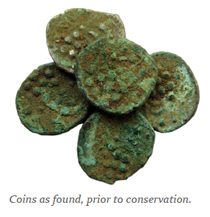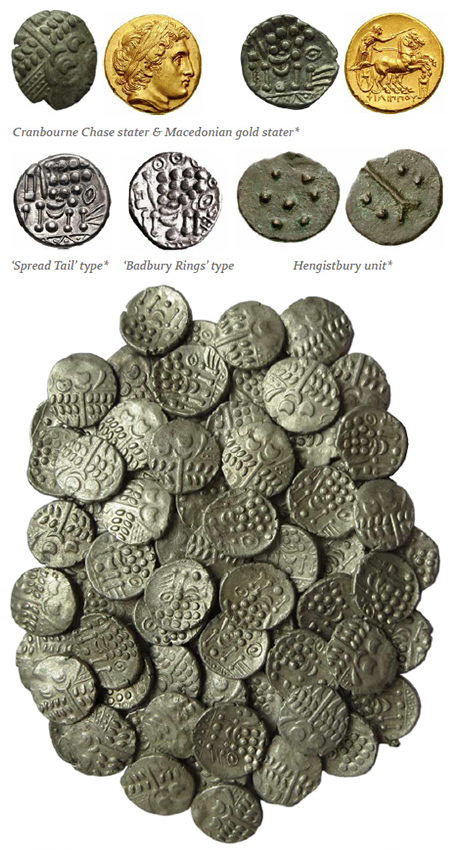The Coins
The Cranbourne Chase stater is evolved from the 4th Century BC Macedonian gold stater and shows a devolved head of Apollo facing right on the obverse and a tripletailed horse facing left on the reverse.
The Cranbourne Chase stater was the longest running series within Iron Age Britain and yet remained uninscribed for its entire duration, why was this? Perhaps a suggestion that there wasn’t one ruler of the Durotriges, perhaps many hill-fort based tribes using the same currency for ease of trade comparative to the modern day Euro. The earliest coins in this series weigh up to 6 grams and have a small gold content, the coins from the Winterbourne Stickland hoard weigh between 5.1 grams and 3.2 grams suggesting they were struck around 50BC-10BC. Interestingly while studying similar hoards in the British Museum it can be noted that the weight range is normally quite small, with nearly 2 grams between the heaviest and lightest in this group perhaps this suggests that they were saved by an individual over a longer period of time.
Aside from the main weight reduction there are a few variations in the Cranbourne Chase stater worth noting, the ‘Spread Tail’ type and ‘Badbury Rings’ type. The continual debasement ended with the Hengistbury series of cast bronze units leading up to 43AD, an example of which can be seen opposite.
Convervation
Due to the presence of copper in the Winterbourne staters they were all heavily encrusted with verdigris (see below) and were crying out to be cleaned to reveal their former glory. This was a painstaking process but we are lucky at Silbury Coins to have in-house conservation specialists who with plenty of time and patience have done a wonderful job in conserving these coins ready to be enjoyed by collectors for centuries to come.
Conclusion
It is always a delight when hearing of a newly discovered coin hoard, more so when we get to handle, research and conserve the coins personally. Something we thoroughly enjoy being a part of and all those who have bought hoard coins from us can share. The downside is that this doesn’t happen very often, an Iron Age coin hoard being found, disclaimed and offered for sale to the private market is a rare event, certainly not to be missed. We will be releasing the coins in batches, to view what we have for sale please see below.
If you have a similar find or collection of coins then feel free to contact us and discuss what we can do for you, be it research, commission sale, auction or outright purchase you will find that Silbury Coins offers a service which will not disappoint.









